Aphids can be difficult insects to control. But how much do we really need to control them? This article explores the aphid life cycle and some different ways to reduce their population without using toxic chemicals.
Where do we see aphids?
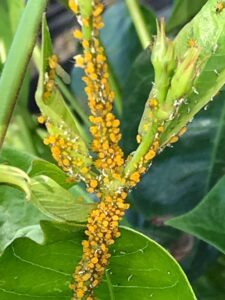
Aphids are sucking insects which feed on fleshy new growth and the undersides of leaves. We look for them at the top of Crape Myrtles where new growth is abundant. We might find them on the flower buds of Tropical Hibiscus, new growth on any species of Milkweed, the undersides of Cabbage or Broccoli leaves or even the undersides of Pecan leaves.
Aphids come in many colors, including green, yellow, red, brown, black, and even blue! (I have only seen blue aphids on Japanese Yew!)
What do aphids look like?
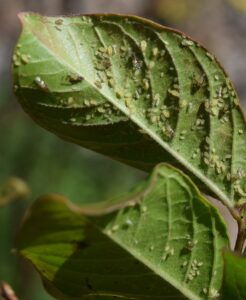
Aphids have fleshy pear-shaped bodies with long legs and antennae. They have a pair of tube-like “cornicles” which project backward from the hind end of their body which are often black in color. Only aphids have cornicles, so if you see these, you have identified your insect! These cornicles emit pheromones to attract other aphids and defensive chemicals to ward off predators.
What damage do aphids do?

Aphids are sucking insects which can be found in large numbers on leaves or stems. Low populations are not too damaging, but when their numbers increase, their feeding can turn leaves yellow, deform flower buds, or even cause leaves to curl and distort new growth. They may also transmit viruses via their feeding to the many vegetables with virus susceptibility such as squash, pumpkin, cucumber, bean, melon and potato.
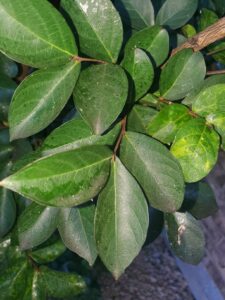
Aphids feed on plant juices, using the protein and secreting the sugars, which they do not use. These sugars are dripped from their anus, causing anything under the plant to be covered with a clear sticky substance. This sugary substance provides an ideal surface for a black fungus called Sooty Mold to grow on. Sooty Mold is not harmful to plants themselves unless it is so prevalent that it prevents light from reaching the leaf and photosynthesis is stopped. There is no control method for Sooty Mold, so reducing the aphid population is the best solution. If your Crape Myrtle trunks have heavy Sooty Mold on them, you can use a soft brush with a mild dish soap solution to clean them.
Why does the aphid life cycle make them difficult to control?
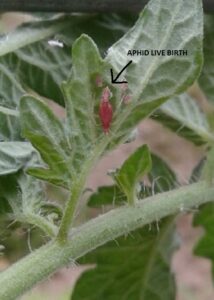
Aphids can give birth to LIVE YOUNG without mating. This asexual reproduction is called Parthenogenesis. They can produce up to 12 young per day, reproducing throughout most of the year in mild climates. The young are called nymphs, and they molt by shedding their skins about four times before becoming adults. You will see these shed skins on close inspection of an aphid infested leaf. The newborn nymph can develop into a reproducing adult within 7-8 days, which greatly adds to the population in a short period of time.

Some aphid species will produce “winged” male and female forms in the fall. These sexual forms mate and produce eggs which will survive harsh weather conditions in the winter. Do not think that a “super freeze” will affect the population in the spring-most insects have an incredible survival mode!
Aphids produce “winged” females in the summer if a plant is overpopulated. They can then migrate to a new location and begin to reproduce again.
What can we do to control aphids?
There are several cultural methods that can be used to reduce the number of aphids.
Removing the parts of the plant that have the greatest infestation. Be sure to bag the plant parts before removing them from your garden so the aphids don’t fall off and spread elsewhere.
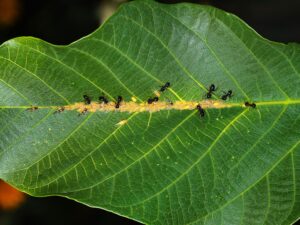 Controlling the ants that “farm” aphids. Have you ever noticed ants going up plant or tree stems? If you have, you should inspect the plant for aphids. Look at the new growth and the undersides of the leaves. If aphids are present the ants will be associated with them. The ants feed on the honeydew produced by the aphids, and in return they will ward off many predators and parasites of the aphids. You can prevent ants from climbing the tree by putting duct tape with the sticky side out around the trunk.
Controlling the ants that “farm” aphids. Have you ever noticed ants going up plant or tree stems? If you have, you should inspect the plant for aphids. Look at the new growth and the undersides of the leaves. If aphids are present the ants will be associated with them. The ants feed on the honeydew produced by the aphids, and in return they will ward off many predators and parasites of the aphids. You can prevent ants from climbing the tree by putting duct tape with the sticky side out around the trunk.
You may want to apply a product called Tree Tanglefoot to the tape to catch even more ants. Do not apply the Tree Tanglefoot directly to the plant as there is a danger of phytotoxicity.
Avoid using high levels of nitrogen fertilizer. Nitrogen forces out fleshy new growth which favors aphid reproduction. Instead, use a slow-release organic fertilizer or urea-based nitrogen fertilizer.
Put row covers over young plants in vegetable gardens to physically exclude aphids and other insects such as squash vine borers. Once the plants are older, they will better tolerate aphid feeding.
Using a strong spray of water directed at the undersides of the leaves will dislodge the aphids. Most will not be able to make it back to the plant.
What are some biological controls for aphids?
Promote beneficial insects which feed on or parasitize aphids by avoiding the use of toxic chemicals which will harm the beneficial insects.
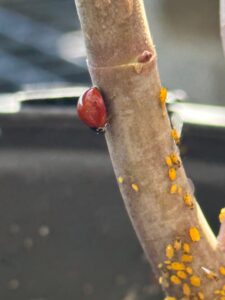
Releasing lady bugs may give temporary control. To encourage them to stay around longer, keep them refrigerated until you are ready to release them. Release them at dusk at the base of the plant or tree with aphids, or in the crotches of limbs so they will crawl higher and search for aphids. Make a second lady bug release two weeks later.
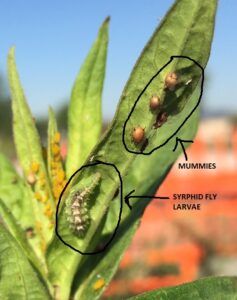
Syrphid fly and lacewing larvae also feed on aphids. Avoiding harsh chemicals will allow them to do their job.
A tiny parasitic wasp is very effective at controlling aphid populations. The wasp lays an egg inside a live aphid. The egg hatches into a parasitic larva that feeds on the inside of the aphid. After killing the aphid, the larva pupates and emerges as an adult wasp. The dead aphid bodies left behind are called “mummies” and are easily seen on the leaf.
What are some chemical methods to control aphids?
Some of you may have skipped right to this section, hoping to find a “magic bullet” to rid yourselves of aphids forever. I’m afraid it is not that easy. An integrated approach is always best when controlling insect populations, and the most toxic methods are usually not the best-at least to our long-term goals.
In order to promote beneficial insects which feed on or parasitize aphids it is best to avoid the use of toxic chemicals that will harm the beneficial insects.
Let’s start with the least toxic to humans, beneficial insects, honeybees, and aquatic wildlife.
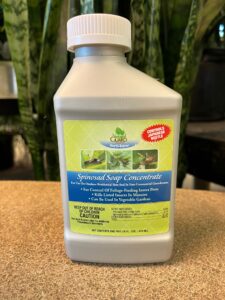
Insecticidal Soap/Spinosad Soap: while there are many formulations out there for homemade soap solutions, the safest and most effective is a commercially produced Insecticidal Soap. It may be used alone or in combination with Spinosad, and organic control for soft bodied insects. Direct the spray at the new growth and undersides of leaves. Thorough coverage is recommended as there is no residual action. Read label directions for dilution rate and re-application intervals.
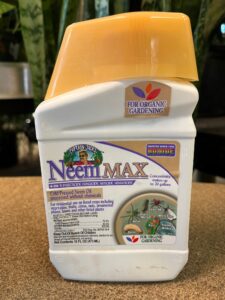
Plant Derived Horticultural Oil: Plant based oil products include Neem Oil or any Horticultural Oil products with Canola oil. Their mode of action lies in quick-drying conditions, which suffocates the insect. Temperatures between 45° and 85°F and low humidity are ideal. Thorough coverage is extremely important, as every nook and cranny must be covered. Only insects present at the time of spraying are controlled.
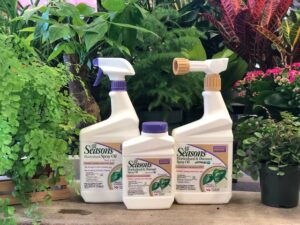
Petroleum Based Horticultural Oil: All Seasons Spray Oil is a mineral oil-based product that may be used when the temperature is between 45° and 85°F and humidity is low-again, fast-drying conditions. Superior oils are highly refined petroleum products which suffocate insects when used as directed. These petroleum-based oils will kill overwintering eggs if applied just as the eggs are beginning to hatch in the spring.

Insecticidal Soap combined with Pyrethrin: This combination may provide a bit more control than Soap alone but have fewer impacts than other chemical controls since pyrethrins break down quickly.
Although I do not like to use systemic insecticides, they are sometimes deemed necessary. Since they are applied to the roots and translocated through the vascular system throughout the plant/tree, they can have negative impacts on predators, parasitoids, and pollinators. They should not be applied to plants prior to bloom.
Imidacloprid: Fertilome Tree and Shrub Systemic Insecticide. This is a systemic neonicotinoid that is diluted with water and applied to the base of the plant in spring. Additional rainfall or irrigation is required to move the product to the roots. It may take several weeks for the product to translocate to the top of tall trees. It is quite toxic to honeybees. Follow label directions precisely.
Acephate: This product used to be known as Orthene. While it may control higher numbers of aphids, they persist in the environment and may kill the natural enemies that provide long term control of aphids. Be sure to follow label directions.
Malathion: Again, control will be better, but the trade-off is the persistence in the environment and the negative effect on predators and pollinators. Malathion is also toxic to cats. As always, follow the directions on the label.
Permethrins: These synthetic pyrethroids may also result in improved control of aphids, but again, it is toxic to honeybees, beneficial insects and aquatic life. Use these and all chemicals carefully and according to directions and precautions on the label.

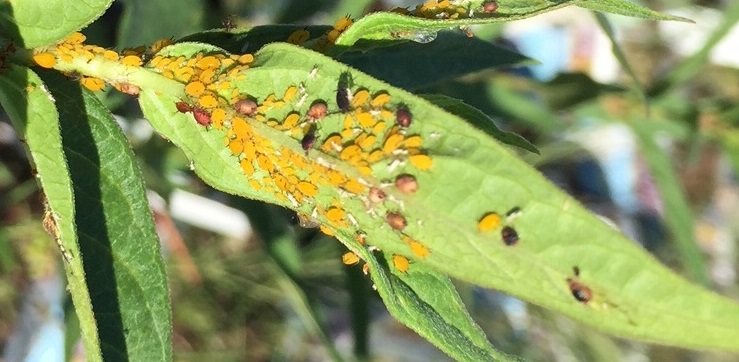

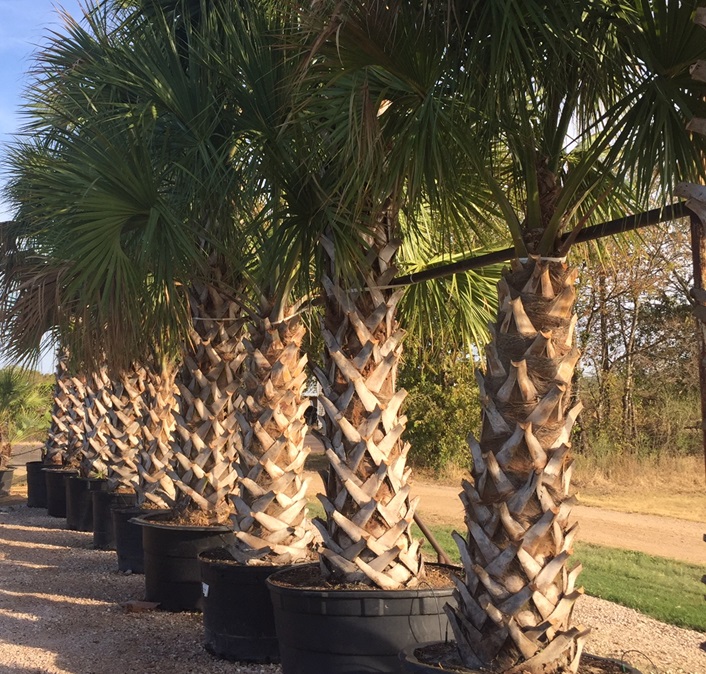
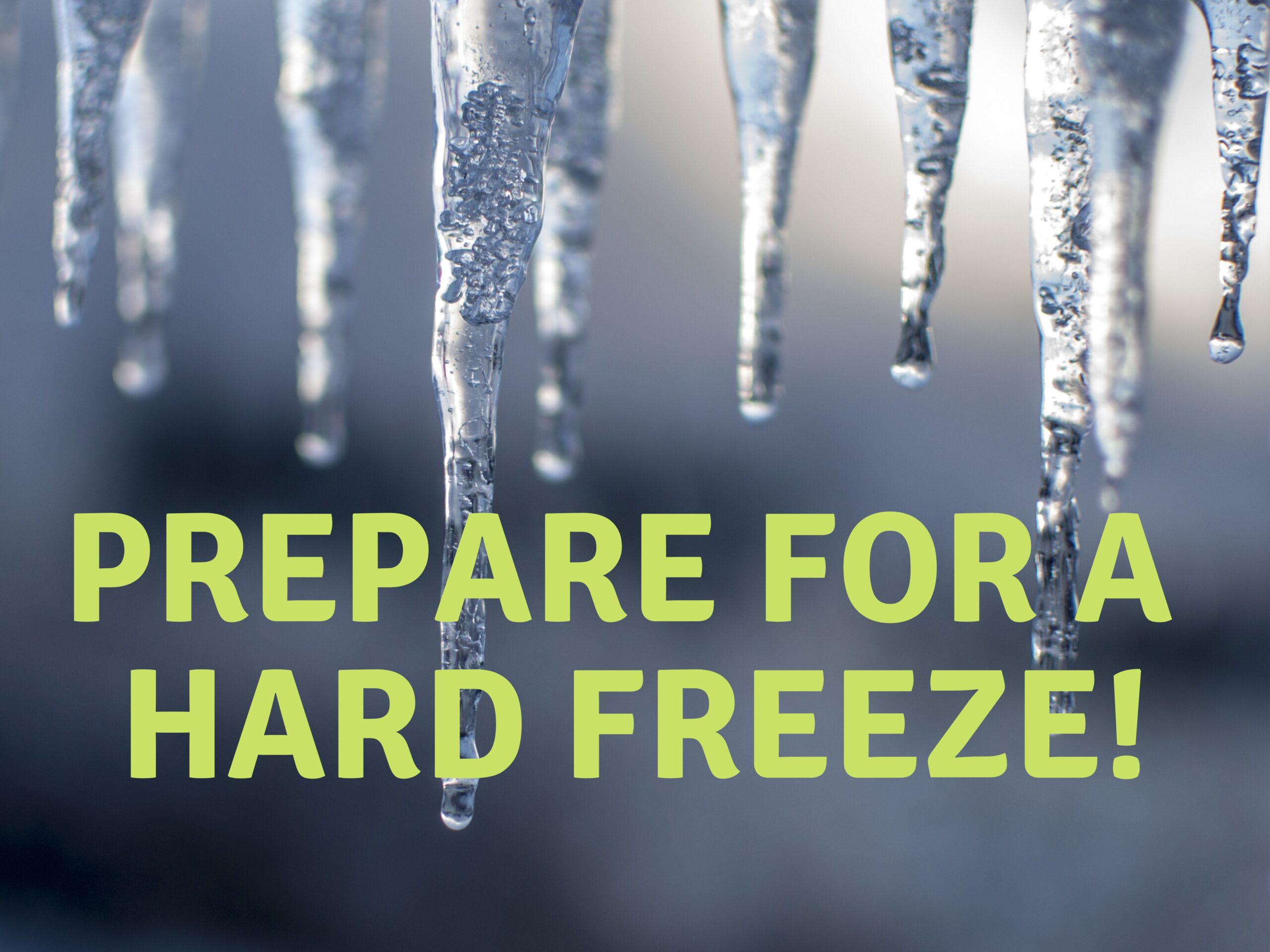
Leave A Comment